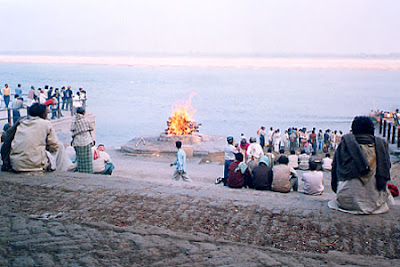Tantra 7 of the Thirumantiram composed by the great Tamil poet Thirumular contains 8 verses 1902 to 1909 that describe what happens when success is achieved in Yoga Samadhi as well as its failures and downfalls. These verses explain why a Jnani’s body is buried and not cremated as well as the ritualistic way in which it needs to be done.
As against common belief that Hindus cremate their dead, there are certain exceptions to the rule. When a Siddhar* fails to achieve Samadhi, he is reborn into this world and continues to worship Lord Shiva from where he had last left off. In the new life that he is granted, he has the complete potential to reach Siddhahood and attains Shiva Yoga, rising into the realm of celestials. When an aspirant goes into Mauna Samadhi he is neither reborn and nor does he attain Jiva Mukta, he is in constant union with the Lord. This is a state of pure consciousness where the body dies but the Siddhar* is still conscious and alive and has completely merged with the Lord. Such a jnani though limited within his human walls during his life time will exude the consciousness that is one with the all pervasive Lord Shiva.
A jnani’s body is never consigned to the flames of a funeral pyre; they say it challenges nature and brings about catastrophic changes to the land where he belonged resulting in disease and famine. Jnani’s are supposed to be buried as per the rules in the Agamic scriptures.
The jnani or Siddhar* is buried in an underground sepulcher which should be located in a riverbed, wooded grove, dense forest or a high mountain valley. The measurements of the sepulcher should be 5 by 5 feet and at a depth of 9 feet. To prepare this chamber, five precious metals and nine rare gems need to be spread within the cave on top of which the seat needs to be placed. Kusha grass is scattered and white holy ash is spread all over the chamber. Further to this turmeric powder in yellow gold mixed with incense is spread over the ash laden grass bed. The cave is square shaped inside and is further covered with garlands of flowers, sandal, musk, and diverse unguents and sprinkled with rose water. The ritual oil lamp is now lit within the cave with complete devotion towards the deceased Siddhar* (jnani). The white holy ash acts as a protective covering around the body. The body is now placed in the appropriate asana and the cave is filled with earth. The Siddhar’s* sandals, earrings and an image with his/her face and eyes decked in suitable clothing are placed over this cave along with rice food and tender coconut. White holy ash is again poured along with powdered incense as well as flowers and vilva leaves. Holy water is sprinkled over this sacred burial chamber and a platform of 3 feet is raised above it. Atop this platform a sapling of a peepal tree is planted or a Shiva Linga is installed. The Sannadhi faces North or East and 16 rituals are performed with complete devotion.
Few Samadhis speak volumes with this approach towards the deceased. Among many Samadhis that dot the Indian countryside some come with excessive divinity, around which the power and magnetic field continues to be strong.



Adi Shankaracharya’s Samadhi, Kedarnath
Samadhi of Siddhar Bogar, Murugan temple at Palani
The small shrine of Adi Shankaracharya at Kedarnath speaks of a Samadhi, at the same place where Adi Shankaracharya is believed to have spent his last days. The cave temple of Siddhar* Bogar, who went into Samadhi in the early part of the Kali Yuga in about 3000 B.C. is even older than that of Adi Shankaracharya. Both Samadhis are found at high altitudes and both have a representation of the Siddhar* and a Shiva Linga installed at the surface. While Adi Shankaracharya’s is a humble version, that of Siddhar* Bogar is a lot more flamboyant. Surrounded by the Nava Durga as well as Sri Bhvaneshwari, and hosting a unique sacred emerald Lingas (Maragada Lingam), not to be found anywhere else in the world along with a right mouthed conch shell, is the self made Samadhi of Siddhar* Bogar, under the main shrine of (Dandapani vigraha) in the Muruga temple at Palani. Interestingly Siddhar* Bogar and Adi Shankaracharya are believed to have traversed the world through air, while the former spread the science of medicine and aviation all the way in China as described in the Saptakanda, the latter went back to his mother during her last moments of life.
The ancient sites of Sanchi, Bharut, Sarnath and Vaishali contain the ash relics of Buddha embedded within a wooden box, with 9 precious stones and earrings of the Bodhisatva. It appears that a square pit was dug here too within the stupa at Vaishali to place these relics and covered with earth, capped by a stupa on top. The gateways depict the life of the Bodhisatva in sculptural representations across their panels.
The sacredness of these shrines leaves us breathless and makes us feel small and not just incompetent but wasteful in our approach for a more perfect life. The question now is “What is perfect living?”
----------------------------------------------------------
*A person who has acquired all the 8 Siddhis during his lifetime is called a Siddhar. Typically Siddhars belonged to the previous yugas including the beginning of the Kaliyuga and lived approximately for a minimum of 125 to 300 years and a maximum that covered a yuga
Also read: Siddhar Bogar Samadhi, Palani Murugan Temple
Credits:
Creative Commons Attribution ShareAlike 2.5, Wikipedia
S.Mahalingam: Painting of Artist Silpi depicting Siddhar Bogar’s Samadhi.































